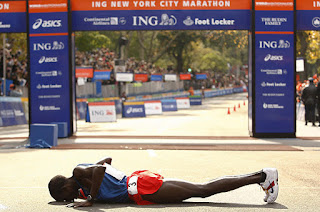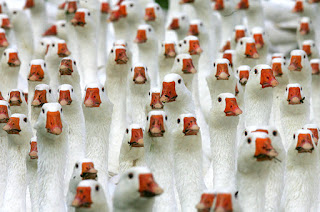1. Ki Suk Han was in a New York subway station when he was pushed down into the train tracks after trying to help a man who was harassing passerby. He wasn't strong enough to lift himself onto the platform away from the tracks and ended up getting hit. The photographer, R. Umar Abbasi, took the photo in attempt of trying to get the flash to warn the trains operators to stop.
2. He said he took the photo in attempts of getting the flash to get the operators attention.
3. I think the photographer should have taken the photo ,because he claims he had already tried to help him and taking the photo wasn't just for a time capture, but an attempt to get the train operators attention.
4. I don't think that the photographer did the best he could to try and save the man. I think this because, a true person would have kept trying and trying until it was honestly too late where as Abbasi decided to get out his camera.
5. I agree with the decision to run the photo on the cover of New York Post. It was a life changing moment I think and people should hear the story of what happened to get Han in that situation. Either way, it isn't a gory photo and shouldn't disturb many people too much util they read it.
6. For a photojournalist, it is more important to capture images of life as it is happening. It is their job to do it and without them some stories wouldn't be stories due to no one remembering.
7. Yes, I think it is ethically acceptable for a photographer to involve him/herself in the situation that they photograph. I think this because as long as the photographer has taken a photo they should be able to try and help.
8. I feel that if a photographer really thinks they need to help they should instead of not trying to influence on the situation.
9. If a photographer is in this situation, I believe they should snap one or two photos then immediately at least try and help with the situation. In this situation specifically, I feel the photographer could have tried harder to save the man.
Monday, December 19, 2016
Monday, December 12, 2016
Final Exam Review
Captions:

James Tiga takes a resting moment on the spot of his finished race. Tiga has been competing in marathons for the past 10 years and is working his way up to the olympics.

Over 60 white ducks are set free after 6 months in a sanctuary. The Steinle Sanctuary is a testing lab for animals, where the 60 ducks were held.
Photography rules:
1. Rule of thirds- instead of centering the photo, imagine a tic tac toe box in the photo and make the subject on one of the intersection points.
2. Balancing elements- when having two subjects/objects, try creating an equal space between them in the center of the photo.
3. Leading lines- getting lines in the photograph draws peoples eyes to the main object at the end
4. Symmetry and patterns- getting shapes in the photo or getting a symmetric theme in the photo.
5. Viewpoint- the angle you take the photo at. Instead of always doing eye level try above or below the object/subject.
6. Background- focusing the image on background forces.
7. Create depth- shooting the image from a normally low point of view. layers of different objects, ex: mountains
8. Framing- using shadows or background to create like a barrier around your photo.
9. Cropping- fitting your image to the page.
10- Avoiding Mergers- making sure to not get the same colors layered on top of each other or cutting out an important part to something.
3.
Aperture- the space that light passes through in a camera.
Shutter speed- how fast the camera exposes and closes the film.
ISO- measures sensitivity of the image sensor. lower setting= less sensitive to light, finer grain. higher setting= used in darker places to get faster shutter speeds.
4. Whats acceptable in manipulating photos in photoshop is changing the light setting so you can clearly see the photo and cropping the photo. Unacceptable would be reshaping objects ect.
5. Portraits
Environmental- the main person is doing something.
Self- focus is on the person.
Casual- not really perfect or planned.
(Formal- set up, planned; Informal- Candid, not perfect)
6.
Exposure- amount of light per unit area hitting the film.
Depth of Field- the difference between the nearest and farthest object in the photo that appear sharp.
Focal Length- the distance between the lens and the image sensor when the object is in focus.

James Tiga takes a resting moment on the spot of his finished race. Tiga has been competing in marathons for the past 10 years and is working his way up to the olympics.

Over 60 white ducks are set free after 6 months in a sanctuary. The Steinle Sanctuary is a testing lab for animals, where the 60 ducks were held.
Photography rules:
1. Rule of thirds- instead of centering the photo, imagine a tic tac toe box in the photo and make the subject on one of the intersection points.
2. Balancing elements- when having two subjects/objects, try creating an equal space between them in the center of the photo.
3. Leading lines- getting lines in the photograph draws peoples eyes to the main object at the end
4. Symmetry and patterns- getting shapes in the photo or getting a symmetric theme in the photo.
5. Viewpoint- the angle you take the photo at. Instead of always doing eye level try above or below the object/subject.
6. Background- focusing the image on background forces.
7. Create depth- shooting the image from a normally low point of view. layers of different objects, ex: mountains
8. Framing- using shadows or background to create like a barrier around your photo.
9. Cropping- fitting your image to the page.
10- Avoiding Mergers- making sure to not get the same colors layered on top of each other or cutting out an important part to something.
3.
Aperture- the space that light passes through in a camera.
Shutter speed- how fast the camera exposes and closes the film.
ISO- measures sensitivity of the image sensor. lower setting= less sensitive to light, finer grain. higher setting= used in darker places to get faster shutter speeds.
4. Whats acceptable in manipulating photos in photoshop is changing the light setting so you can clearly see the photo and cropping the photo. Unacceptable would be reshaping objects ect.
5. Portraits
Environmental- the main person is doing something.
Self- focus is on the person.
Casual- not really perfect or planned.
(Formal- set up, planned; Informal- Candid, not perfect)
6.
Exposure- amount of light per unit area hitting the film.
Depth of Field- the difference between the nearest and farthest object in the photo that appear sharp.
Focal Length- the distance between the lens and the image sensor when the object is in focus.
Subscribe to:
Comments (Atom)

